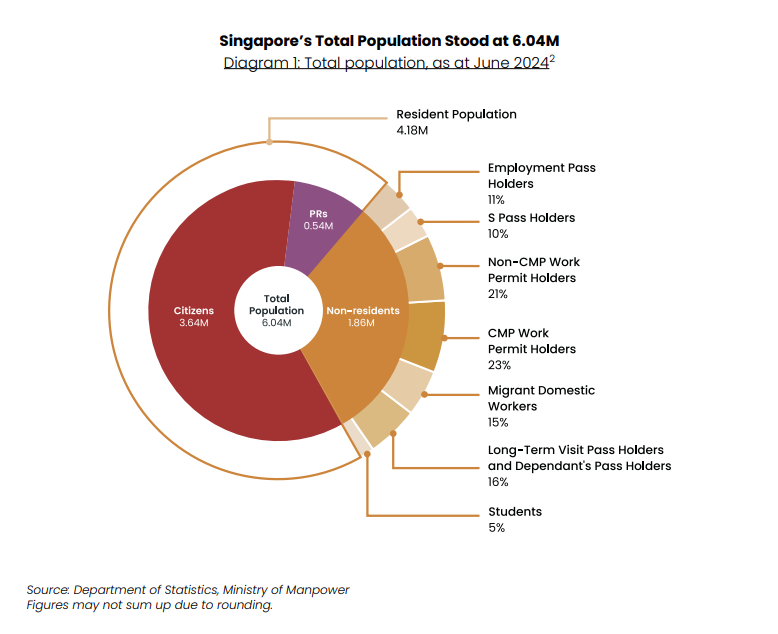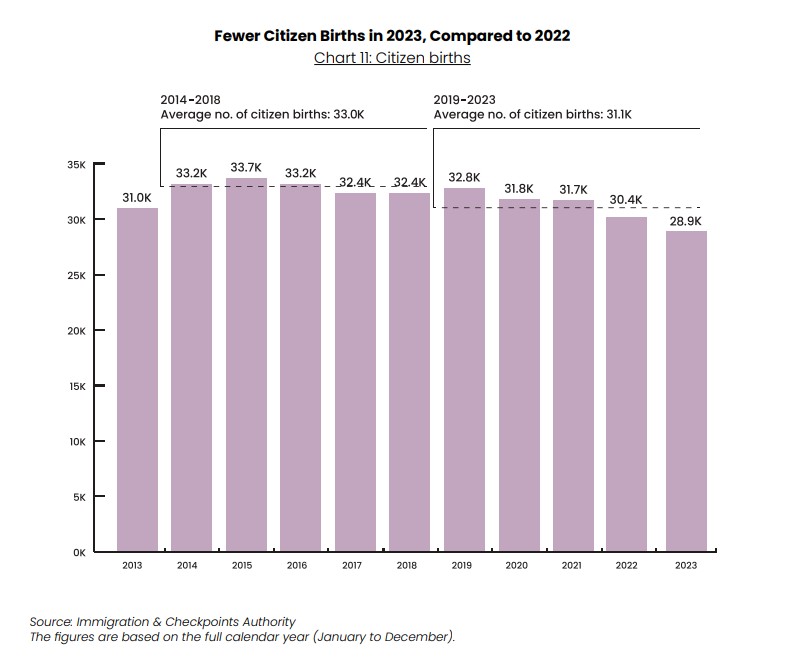Singapore’s population is now the largest it has ever been in a decade. This milestone was revealed in the latest Population in Brief report by the National Population and Talent Division (NPTD).
As of June 2024, our population stands at 6.04 million, a 2% increase from June 2023.
But before you start wondering where the sudden baby boom came from, the growth actually came mainly from a 5% rise in the non-resident population.
Rising Non-Resident Population
So, who exactly are these non-residents driving the growth?
These are your migrant domestic workers, international students and various work pass holders who help fill in the job gaps in areas that are unpopular with locals like construction, caregiving and more.

Currently, 1.86 million non-residents live and work in Singapore, a noticeable jump from the 1.77 million in 2023, and their numbers are expected to continue to grow steadily.
Work permit holders, who make up 44% of the non-resident population, contributed the most to this spike. These semi-skilled managers, technicians, and executives are largely employed in sectors like construction, manufacturing, and marine shipyards (CMP).
With many companies rushing to catch up on projects delayed by COVID-19, the demand for these workers has surged.

Despite this sudden rise in non-residents, experts say it’s nothing unusual.
Speaking to The Straits Times, Christopher Gee, the Deputy Director and senior research fellow at the Institute of Policy Studies, pointed out that global cities like New York City also have similar non-resident numbers.
What About the Locals?
The resident population has been increasing but at a much slower rate. The citizen population only increased by 0.7%, reaching 3.64 million as of June 2024. Meanwhile, the permanent resident (PR) population saw a slightly higher increase of 1.2%, bringing the total to 544,900.

Marriages and Births on the Decline, Growing Number of Singles
This slow growth in the citizen population can be traced back to the low number of marriages and births, with Singapore’s Total Fertility Rate (TFR) hitting an all-time low of 0.97 in 2023.
TFR measures the average number of children a woman is expected to have in her lifetime, and Singapore’s current rate is well below the replacement level of 2.1 that’s needed to keep the citizen population stable.

In 2023, only 28,877 citizen births were recorded, a 5.1% decrease from the 30,429 births in 2022.

Marriage rates are also on the decline. There were just over 24,000 citizen marriages, a 1.7% drop from 2022. People are getting married later in life, with the average age for first marriages being 30.7 for grooms and 29 for brides.

And more people are choosing singledom, with a higher proportion of singles among citizens of all age groups compared to ten years ago.

However, some marriage trends are surviving. On average, in the past 10 years, 1 in 3 citizen marriages were to non-citizens. In 2023, this number bounced back to pre-pandemic levels, with 36% of all citizen marriages being transnational, nearly matching 2019’s 37%.
Post-COVID travel restrictions, these cross-border unions have once again become a common feature in Singapore’s marriage landscape.

So, we’re not growing fast enough. But how does our current citizen population look like?
An Increasing Silver Generation
Ageing continues to be a growing problem. As of June 2024, almost 20% of the citizen population was aged 65 or older, a big jump from the 12.4% a decade ago.

Small Increase in New Citizens
In terms of new citizenships granted, the average number given each year has seen a slight increase. Over the past five years, Singapore granted an average of 22,400 citizenships and 32,600 permanent residencies annually, increased slightly from the 2015 to 2019 period.

What’s Next?
Experts like Mr Gee have suggested that Singapore might reach a population of 6.37 million by June 2030.
But before you panic about overcrowded MRTs and longer lines at hawker centers, those same experts assure us that this is still comfortably below the much-debated 6.9 million mark proposed in the government’s 2013 White Paper.




